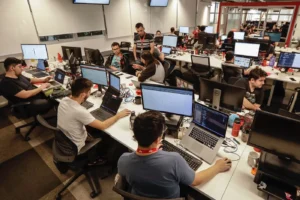Find out why this digital network brings more agility and confidence to transactions
Who has heard of cryptocurrencies It is NFTs You have certainly come across the term blockchain. This is an essential word in beaba of innovation, and despite being almost always related to Bitcoins (virtual currencies), the blockchain it is a network that can be used in any market.
The name itself explains what it came from: it is a way of storing digital data in blocks (block) that are linked together, forming a chain (chain). In this network, each block has a unique identity and carries information about its entire transaction history.
Every block has a kind of fingerprint, a unique code that identifies each transaction, like a sale, for example. With each new transaction (such as a resale), this previous code is linked to the new block, which carries the previous history, preventing it from being tampered with. In this way, each new block reinforces the validity of the previous one and strengthens the entire chain. That is why it is considered immutable and fraud-proof.
Ultimately, the blockchain It can be compared to a large accounting book where all the records of a transaction are placed on a digital plane. These registries are open to everyone, so everyone knows where an asset came from and who it has belonged to since it was registered, making the chain transparent. These assets, in fact, can be tangible (such as a house, a car and even money, such as cryptocurrencies) or intangible (such as patents, copyrights and brands).
These chains can be public (like Bitcoin) or private. Every time the creation of a network is authorized in the blockchain, anyone who wants to participate must necessarily prove their identity and that the goods or assets being traded are exactly as they are digitally represented.
How companies use blockchain
Despite being open, block data is never changed in the blockchain. When there is an error, for example, a new transaction must be recorded, and both the right and wrong transactions are visible to people.
For a transaction to be considered legitimate, all participants must agree to its validity. In other words, it is the community, and not an external authority, that endorses transactions.
Therefore, this technology facilitates the registration process and also the tracking of an asset in a business network. At the blockchain, anything can be tracked and traded with certification of ownership or authenticity.
In this way, transaction risks are reduced, as are costs. This is why cryptocurrencies, for example, are traded in blockchain. Bitcoin, the most famous of them, is entirely based on this network. In short, it's as if the blockchain was the operating system and Bitcoin was one of the applications that run on it.
But besides Bitcoin, many other assets can be traded on the blockchain. With the emergence of NFTs, for example, artists are already selling their works on this digital chain. And the NBA (basketball league in the United States) uses technology to sell digital collectibles of its main players, such as LeBron James, with a certificate of authenticity.
Companies have already used the blockchain to improve your operations in the physical world as well. Walmart, for example, created a system to track the production chain of foods sold in its store, the list points out. Blockchain 50 2021, carried out by Forbes. And Boeing has developed an air traffic control system for drones that is enabled by blockchain. It seems that not even the sky is the limit for this technology.


